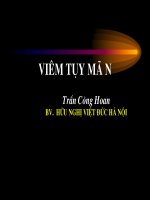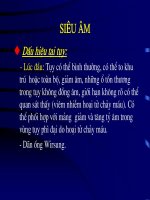CT viem DT2004
Bạn đang xem bản rút gọn của tài liệu. Xem và tải ngay bản đầy đủ của tài liệu tại đây (1.57 MB, 76 trang )
Figure 1.
Normal colon. Drawing shows the
structures of the colon, including
the teniae, haustra, and appendices
epiploicae.
1
Figure 2.
Colonic interposition. Drawing shows the
colon interposed between the liver and the
diaphragm.
2
. Figure 3. Colon in empty renal fossa in
a 55-year-old man who underwent
nephrectomy for renal cell carcinoma.
Contrast material-enhanced spiral CT scan
shows the colon (C) and spleen (S) located
in the left renal fossa.
3
Appendicolith. Drawing shows an
appendicolith that obstructs the
appendiceal lumen, resulting in dilatation
of the appendix and wall thickening.
4
. Normal appendix. Contrastenhanced spiral CT scan shows a
normal air-filled appendix (arrow).
5
Figure 6. Appendicitis. Contrastenhanced spiral CT scan shows a dilated,
fluid-filled appendix (arrows). Minimal
inflammatory changes are also present in
the adjacent mesenteric fat.
6
Figure 7. Appendicitis in a patient with
acute-onset right lower quadrant pain.
Spiral CT scan obtained with oral and
intravenous contrast material shows
enlargement of the appendix, which is
filled with fluid (arrows). Adjacent
inflammatory stranding is also present.
Intravenous contrast material can help
define the thickened walls of the appendix.
7
Figure 8. Appendicitis in a patient with
acute-onset right lower quadrant pain.
Nonenhanced CT scan shows moderate
inflammatory changes in the right lower
quadrant. An appendicolith is identified
(arrow).
8
Figure 9. Periappendiceal abscess in an
80-year-old woman with right lower
quadrant pain and fever. Contrastenhanced CT scan shows an inflammatory
mass with an air-fluid level in the right
lower quadrant (arrow) and associated
inflammatory changes in the pericecal fat.
A periappendiceal abscess was discovered
at surgery.
9
Figure 10. Epiploic appendagitis in a 16year-old girl with severe left lower
quadrant pain. Contrast-enhanced spiral
CT scan shows a 2.5-cm-diameter mass
(straight arrow) with fat attenuation and
mesenteric stranding. The mass is adjacent
to the descending colon (curved arrow) and
was thought to represent inflammation of
the appendix epiploica on the basis of the
CT findings. The patient was treated
conservatively, and the pain resolved
within 24 hours.
10
. Diverticulosis. Drawing shows colonic
diverticulosis and circular muscle
hypertrophy.
11
Figure 12. Diverticulosis. Spiral CT scan
obtained with oral and intravenous contrast
material shows moderate diverticulosis of
the sigmoid colon.
12
Figure 13.Diverticulitis. CT scan
obtained with oral and intravenous
contrast material shows wall
thickening in the sigmoid colon
(arrows) with adjacent
inflammatory changes in the
pericolic fat.
13
Figure 14. Diverticular abscess. CT scan
obtained with oral and intravenous contrast
material shows moderate wall thickening
in the sigmoid colon (S) with significant
adjacent inflammatory changes and
stranding of the pericolic fat. A 3-cmdiameter fluid collection (*) is seen
between the sigmoid colon and bladder
(B), a finding compatible with a
diverticular abscess
14
Figure 15. Colovesical fistula. CT scan
obtained with oral and intravenous contrast
material shows moderate wall thickening
in the sigmoid colon (S) with adjacent
inflammatory changes and stranding of the
pericolic fat. Focal wall thickening is seen
in the left posterior part of the bladder
adjacent to the inflamed sigmoid (arrow).
A moderate amount of air is also present in
the bladder, a finding compatible with a
colovesical fistula. Small collections of
retained barium are identified within
diverticula.
15
Figure 16 Diverticulitis. CT scans
obtained with oral contrast material show
focal thickening of the sigmoid colon
(straight arrow) with adjacent
inflammatory changes in the pericolic fat.
This appearance can be difficult to
distinguish from that of colorectal cancer.
However, the presence of mesenteric fluid
(curved arrow in a) favors diverticulitis.
16
Figure 17.
Typhlitis. Drawing shows the significant
wall thickening that involves the cecum in
patients with typhlitis.
17
Figure 18. Typhlitis in a patient with
acute myelogenous leukemia.
Nonenhanced CT scan shows inflammation
and marked thickening of the cecum
(arrowheads), findings compatible with
typhlitis. Minimal pericecal inflammation
is present in the adjacent mesenteric fat.
The descending colon (D) appears normal.
18
Figure 19. Radiation fibrosis. Drawing
shows smooth wall thickening and fibrosis
in the sigmoid colon, which narrow the
colonic lumen.
19
Figure 20. Radiation proctitis in a 38year-old woman who underwent radiation
therapy for cervical cancer. CT scan of the
pelvis shows marked thickening of the
cervix and vagina (curved arrow) with
necrosis (open arrow), findings compatible
with known locally invasive cervical
cancer. Marked thickening of the rectum
due to radiation colitis is also present
(solid straight arrows).
20
Figure 21. Crohn disease. CT scan
obtained with oral contrast material shows
moderate thickening of the terminal ileum
(curved arrow) and cecum (straight arrow)
with adjacent inflammatory changes in the
pericolic fat.
21
Figure 22. Ulcerative colitis in a 27-yearold man. Contrast-enhanced CT scan
shows minimal diffuse thickening of the
sigmoid colon with minimal inflammatory
stranding. The remainder of the colon was
normal (not shown).
22
Figure 23. Crohn disease. Drawing
shows submucosal fat in the cecum and
terminal ileum.
23
Figure 24. Crohn disease. CT scan obtained with oral contrast material
shows low-attenuation submucosal fat in the ascending colon (arrow) and
fibrofatty proliferation of adjacent mesenteric fat (*).
24
Figure 25. Ulcerative colitis. CT scan of
a patient with long-standing ulcerative
colitis shows a submucosal halo of fat
within the rectum (arrow). There is also
perirectal fibrofatty proliferation (*).
25









